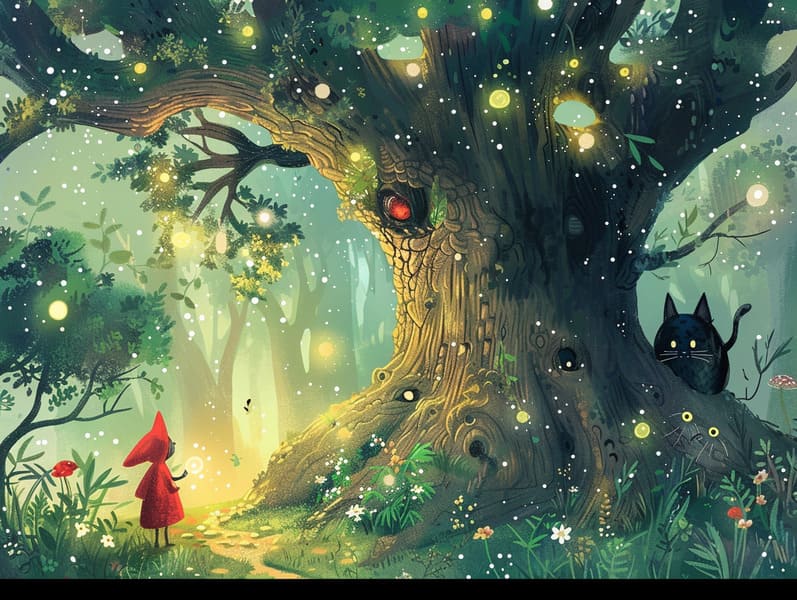
Popular fairy tales have legendary status. These stories have been relayed from one generation to the next long before they were ever documented. They came from a variety of societies, including Western traditions. They were initially conveyed among elders, often carrying themes and messages concerning the societal norms and beliefs of the time.
The Grimm brothers, Jacob and Wilhelm (the Grimm brothers), were among the first to compile and publish many of these beloved narratives. Their volume, "Grimm's Children's Stories," included tales like "The True Bride," "Little Brother and Little Sister," and "Snow-White and Rose-Red," which have since become pillars in the world of children's fairy tales. Similarly, H. C. Andersen's enchanting narratives, such as "The Story of the Little Mermaid," and "The Duckling that Could," have touched hearts worldwide, establishing their place in the pantheon of beloved fairy tales.
Despite being ancient, these stories remain as significant as ever, especially as bedtime stories for kids. These charming stories are now available in different formats, including artistically illustrated books, delightful animations, and digital fairy tales.
Their lasting presence can be linked to several fascinating points:
Crucial Morals: Classic fairy tales often present important moral lessons. Stories like "The Story of the Boy Who Cried Wolf" teach the importance of being truthful, while "The Tale of the Tortoise and the Hare" demonstrate the qualities of resolve and meekness. These narratives offer kids clear distinctions between ethical and unethical, molding their moral compass in a subtle yet lasting way.
Empathy and Understanding: Old fairy tales frequently illustrate protagonists facing problems and hurdles, motivating listeners to connect with their struggles and boost their triumphs. For instance, "The Story of Beauty and the Beast" points out the virtue of appreciating inner worth to perceive the inner self of a person, building understanding and appreciation.
Cultural Appreciation: Many traditional fairy tales are interwoven with the cultural contexts from which they were born. Engaging with these fairy tales can provide captivating looks into different heritages, strengthening a sense of cultural respect and comprehension.
Imagination and Innovation: The fanciful elements in old fairy tales—mythical entities—unleash children’s imaginative ideas. These fairy tales move readers to imaginary realms, boosting imaginative ideas and a sense of astonishment that lasts a lifetime.
Traditional fairy tales are not only captivating but also illuminating. They serve as mesmerizing tools in strengthening various intellectual and emotional capacities in little ones. When classic fairy tales are told out loud, they enhance speaking abilities by offering new terms and complicated sentence structures. This practice also develops auditory skills and focus, as little ones remain attentive, looking forward to see what happens next.
Furthermore, talking about the themes and characters of ancient fairy tales can cultivate analytical skills and logical thinking. Little ones are instructed to notice patterns, expect results, and realize cause and effect. These reflections also encourage the young verbalize their thoughts and feelings, contributing to their emotional intelligence.
In today’s information age, the presence of internet fairy tales has made these stories more attainable than ever. Digital sites and mobile apps offer large libraries of classic fairy tales that can be looked at or listened to anytime, anywhere. Fairy tales told out loud are particularly sought after, providing an enjoyable way for the young to savor these spellbinding stories. Read-aloud books and narrated videos transport characters and settings to life, often supported by mesmerizing harmonies and musical scores that improve the narrative adventure.
The lasting appeal of classic fairy tales lies in their ability to evolve to present eras while holding onto their basic principles. Contemporary modernizations of these stories often highlight more multicultural protagonists and modern settings, making them familiar to today’s audience. However, the central morals of bravery, warmth, and fairness remain unchanged, check it out continuing to impact readers of all ages.
Traditional fairy tales also offer a sense of familiarity and knownness. They extend a orderly narrative with a clear beginning, middle, and end, often ending with the finalization of conflicts and the triumph of virtue over vice. This constancy can be solacing for children, spreading a sense of steadfastness in an inconstant world.
Ancient fairy tales continue to fascinate and inform new generations, maintaining their grace and meaningfulness in modern society. As nighttime stories for kids, they grant a perfect blend of captivation and insight, aiding moral values, empathy, and creativity. The abundance of online fairy tales and the widespread nature of fairy tales read aloud assure that these timeless tales remain accessible to new generations.
By conserving and circulating these narratives, we continue to laud the rich tapestry of myths and cultural heritage. Whether you are enjoying a colorful picture book, accessing a digital collection, or listening via an read-aloud story, the splendor of traditional fairy tales is always within reach. These tales demonstrate of the unending force of stories and its ability to join us across time and space.
Whether you are browsing a colorful picture book, accessing a internet library, or listening to an audio story, the majesty of classic fairy tales is always within reach.
These fairy tales point out of the everlasting force of narratives and its ability to gather us across epochs and places, weaving a spell that charms and informs alike.